Hallsville Independent School District
School Information
- School Address: P.O. Box 810 , Hallsville, TX 75650, US
- School Phone: 903.668.5990
- School Fax: 903.668.5979
- Superintendent: Jeff Collum
- Contact E-Mail: adaub@hisd.com
- Web Address: http://www.hisd.com/
Demographics
- Number of Students: 5,070
- Percent Eligible for Free and Reduced Lunch: 40.8%
- Percent of Limited English Proficient: 4%
- Percent of Special Education: 8.2%
Schools in District
-
Hallsville North Elementary School (K-3)
Hallsville East Elementary School (Pre K-3)
Hallsville Intermediate School (4-5)
Hallsville Junior High School (6-8)
Hallsville High School (9-12)
Racial/Ethnic Percentages:
- White: 72.5%
- Black: 6.5%
- Hispanic: 15.1%
- Asian: 0.9%
- Native Hawaiian or Other Pacific Islander: 0%
- American Indian or Alaska Native: 0.3%
- Multiracial: 4.7%
- Other: 0%
In 2006 Hallsville Independent School District began to implement school improvement and the concepts of professional learning communities. The district began with goal setting and providing significant levels of training in the school improvement research and strategies including PLC. District and campus teams have studied the work of Rick and Rebecca Dufour as well as the other leaders in the PLC initiative. The 90-90-90 research by Dr. Douglas Reeves and the research by Dr. Bill Daggett were also studied. The components of highly successful schools outlined in Dr. Daggett’s work were studied and incorporated into the districts plans for improvement. As district and campus teams began to embrace this research, the district committed to sending both district and campus teams to multiple Professional Learning Communities conferences/summits. The district has hosted two in-district summits with Mike Mattos and Sharon Kramer. Ken Williams, Maria Nielsen, and Paula Rogers have provided in district training to teacher and leader teams. Annual training in PLC and RTI is included in the annual district staff development calendar. District leadership is committed to being leaders of leaders and role models in the district functioning as a PLC. At the district and campus level Mission, Vision, Values and Goals are updated annually.
The district-level Instructional Leadership Team consisting of all Principals and Directors and led by the Deputy Superintendent models the use of norms for all meetings. This practice is then carried out by campus level teams. Each common planning team at every campus uses the four questions essential for learning in weekly planning meetings that occur during the school day. These four questions are referred to as “The Four Big Questions” in our district and guide the work of both curriculum writing at the district level, and curriculum planning at the campus level. Campuses are required to have common planning time during the school day, but have the flexibility in determining “how” this happens. All Principals receive leadership coaching.
Hallsville ISD has committed itself to maintaining high quality/high impact staff development. The district has recently began a Back to School Mini Conference where HISD teachers & staff are the presenters. This allows our own staff to showcase their areas of expertise and other staff from across the district to learn from their peers.
A Balanced Literacy Coach/Trainer has worked with the district since 2006 to provide the training necessary to fully implement the concepts of Balanced Literacy. All campuses K-8 have both Literacy and Math Interventionist/Instructional Coaches. Hallsville High School has a Math Interventionist/Coach. Coaches have received direct training from our Literacy Trainer, Dana Center and Coaching for Results. This provides them the skills necessary to implement a coaching model with fidelity. Instructional Coaches work directly with teachers to provide training and support.
In grades K-12 teachers have worked collaboratively with the technology department to creatively integrate technology into instruction with the use of interactive white boards, iPods, iPads and Chromebooks. This has been supported by an extensive training and support plan. Staff members can schedule one-on-one technology training on “Super Technology Saturdays” provided by the Hallsville ISD Technology Department. In an effort to reach “all” students HISD has expanded the services of high school students who are Homebound due to accident or illness to include tutoring and assistance via “Skype” and “Google Hangout”.
Training in strategies and interventions to support students with disabilities in a general education / co-teacher setting is provided in an on-going manner by outside consultants each year. The HISD Co-Teach program and the integration of technology into that program was recently featured at SxSW.EDU in Austin, Texas.
The Hallsville ISD Board of Trustees has received training in the PLC concepts on multiple occasions and fully supports the Mission, Vision, Values, and Goals that have been developed. They are partners in the district PLC initiative.
A PLC/SMART Goals Implementation Guide was developed at the district level and is provided annually to each principal to provide guidance and support in the full implementation of PLC concepts. This guide includes helpful tools, forms and procedures for principals and other leaders to facilitate their work. Each campus principal is required to submit their plan for achieving his or her campus’s SMART Goals to the Deputy Superintendent. This provides district administrators the opportunity to review and discuss plans with principals and provide the support necessary for success.
The district evaluation process has been revised so that all district administrators have their SMART goals as a part of an overall evaluation process.
Administrator Testimonials
1. Monitoring student learning on a timely basis.
All campuses are required to have planning time for teachers to meet as groups built into the school day. Teachers use lesson planning guides that are based on the four questions essential for learning: What do we expect students to learn? How will we know if they have learned it? What will we do if they have not learned it? And, what will we do if they already know it? All instructional planning meetings are centered around these four questions.
The district has a comprehensive curriculum and assessment writing process. Teacher Leaders from every grade and campus receive training in curriculum writing and assessment writing. They design the district curriculum that is based on the Texas Essential Knowledge and Skills. These curriculum guides are provided to all staff and promote equity between classrooms. They are essential to weekly instructional planning meetings. Curriculum writing is supported by the district curriculum department as well as consultants, and regional education service centers.
Common assessments and benchmarks are used by every grade and subject in the district as a primary manner of gauging student progress and assigning interventions for students. The curriculum and assessment writing process is vital to the success of students. This is a cohesive process that has been put into a handbook so that all staff members understand the purpose, timelines, processes and procedures for curriculum and assessment writing.
HISD has a data monitoring process that gives purpose and meaning to all data meetings in the district. In our district we believe that PLC/RTI are one cohesive system that operates for the best interest of all students in the district. Each campus and department reviews student data on all students in the district on a regular basis (approximately every three weeks). The district data meeting process is central to having one cohesive system that supports all students.
At the district level teams of administrators review student data several time per year to look for trends in achievement that may reflect a need to address levels of support or changes in curriculum. This is a very collaborative team that works to solve any achievement problems that are occurring as quickly as possible. It is not uncommon for this team to agree to temporarily shift support staff from one grade to another or one campus to another to meet specific instructional or training need.
2. Creating systems of intervention to provide students with additional time and support for learning.
The district has focused its efforts on creating a systematic intervention process (RTI) that works hand-in-hand with our Professional Learning Committees (PLC) initiative. RTI and PLC are not separate processes in the district. It is one cohesive system that is designed to provide students with the time and support necessary to be highly successful.
The systems that are in place to design and monitor student interventions are:
- Weekly curriculum meetings at every campus’ addressing the four questions essential for learning.
- Student intervention teams at every campus. These teams monitor students who have formal intervention plans.
- Each campus has teams (i.e, pyramid meetings, family meetings, pod meetings, department meetings, and campus data meetings) that regularly meet to review the progress of students.
- The district has a four-tier intervention process for academic and behavioral support.
Tier I: High Quality Core Instruction -- Classroom Teacher Intervention
Tier II: Targeted Small Group Intervention
Tier III: Intensive, Prescriptive, Individualized Intervention
Tier IV: Consideration/Testing to gain more in-depth evaluation data and determine if there is a need for services via Special Education.
|
RTI Components by Tier |
Description |
Procedures for Implementation |
|
|
100% of students receive Tier 1 Assessments and Interventions |
Tier 1 · Universal screening 3 times a year · Diagnostics · Progress monitoring High-quality instruction and behavioral supports are provided for all students in general education. |
· Collection and sharing of benchmark data among teachers, principals, district staff, and parents at campus data meeting · Specific, objective measures of problem areas, not anecdotal information or opinions |
· School personnel conduct universal screening of academic and behavioral skills. · Teachers implement a variety of research-supported instructional strategy. · Continuous progress monitoring is used to guide high-quality instruction. · Students receive differentiated instruction based on data from ongoing assessment. |
|
Approximately 15% receive Tiers 1 and 2 |
TIER 2 · Baseline data collection · Diagnostics · Progress monitoring · Comparison of pre- and post- intervention data Students whose performance and rate of progress lag behind those of peers in their classroom, school, or district receive more-specialized prevention or remediation within general education. · District classroom teacher documentation · Data entered into DMAC |
· Curriculum-based measurement (CBM) to determine whether a problem are is an issue with the student or the core curriculum · Which interventions will be tried that are different? Who will do them? When? Where? For how long? · Frequent collection of a variety of data to examine student performance over time and evaluate interventions in order to make data-based decisions · Data-based decision making for intervention effectiveness are completed in the campus RTI meetings |
· Curriculum-based measures are used to identify which students continue to need assistance with specific kinds of skills. · Collaborative Problem solving is used to design and implement instruction support for students that may consist of more-individualized strategies and interventions through RTI meetings. · Student progress is monitored frequently to determine intervention effectiveness. · Systematic assessment is conducted to determine the fidelity with which instruction and interventions are implemented. · Parents are informed and are involved in planning. |
|
Approximately 5% receive all 3 Tiers |
TIER 3 · Increased intensity of interventions · Data entered into DMAC Tier 3 includes all the elements of Tier 2. The difference between Tier 2 and Tier 3 is the frequency and group size of the intervention treatment. |
· The most intensive phase of RTI · Fidelity of intervention ensured by documentation · If progress monitoring does not establish improvement after intervention phase I implemented, referral to multidisciplinary assessment for special education is warranted. |
|
|
TIER 4 Tier 4 includes all of the elements of Tier 1-3 |
· Student referral to SPED · If student qualifies for SPED a full continuum of interventions will be offered through special and general education instruction. |
· Procedures will include all of the components of Tiers 1, 2, and 3. |
All students at all campuses have systematic interventions offered to them in order for them to receive the necessary time and support to be successful. All interventions are available to every student based on their identified need. The district has committed to having prescriptive interventions based on the student’s specific identified need. The district does not have a “one-size fits all” intervention model. The intervention a student is assigned to is based on data. The success of the student is monitored and if necessary the amount of time or type of intervention is adjusted. The district is committed to providing services to students with disabilities in an inclusive setting. A full continuum of services is offered while every effort is made to offer instruction in the general education setting. A very comprehensive co-teach support model is utilized at every campus. This allows a certified special education and general education teacher to partner and provide services to a classroom of students and allows the students with disabilities to have the support they need while being instructed with on-grade level curriculum. A Behavior Support Program offers students with emotional and behavioral issues the support that is needed while being successful in a general education setting. The instructional models are supported with a comprehensive training and consultation program for staff.
The time created for interventions within our school day looks different across campuses throughout the district. Some campuses have a built in time during the day in which students are receiving intervention, support, review or enrichment based on their need. This scheduled time stays consistent, but their level of support changes as mastery of skills change. At other campuses, interventionists work with teachers to develop very specific schedules to ensure that students will not be pulled for interventions during new instruction. At the secondary campuses, depending on the tier of intervention, some students may have an intervention class scheduled into their day.
Research based interventions include:
- Literacy Groups
- Imagination Station
- Leveled Literacy Intervention
- Behavior Inclusive Support Model
- Flexible Scheduling
- Targeted Small Group Tutorials
- Motor Labs
- Grand Central Station
- Read 180 Enterprise
- School-Wide Content Mastery
- Male and Female Adult Mentoring Programs
- Lunch Bunch Tutorials for Intentional Non-Learners
- Homework Club
- Credit Recovery
- Student Mentoring Program
- Technology-based Science tutorials
- Read Naturally
- FastMath
- MTA
- Transition program for incoming Jr. High and High School Students
- E 20-20
- Research based small group instruction
- Ascend Math
- Fast Forward
- EdMark Reading
3. Building teacher capacity to work as members of high performing collaborative teams that focus efforts on improved learning for all students.
Hallsville ISD is committed to working as a Professional Learning Community. We subscribe to the concepts of “Learning by Doing” and know that as educators we are on a continual path of learning and improvement.
At the district level, this commitment includes on-going comprehensive training in the concepts of Professional Learning Communities. All district level administrators and teams of teacher leaders from every campus have received both formal training through their attendance at several PLC Institutes as well as informal training from book studies and presentations by staff members. The district has a commitment to maintaining this initiative through on-going training for both new and tenured staff members. The district maintains a very extensive library of PLC training resources for book studies, training and presentations during each school year.
At the district level administrators meet to review district-wide student achievement data, collective inquiry of best practices, and to determine needed changes in curriculum/assessment practices. This group of instructional leaders models the practices seen at campuses by using SMART Goals and a Mission, Vision, and Values Statement to guide their work. All meetings have norms established.
All planning meetings and lesson planning in the district are centered around the four questions essential for learning”. Our plans and responses to these questions lead to the continual improvement of instruction as well as interventions. Each campus is required by the district to schedule collaborative planning and data review meetings within their school day. Each campus has modified their schedule in order to provide a minimum of 45 minutes to 1 hour of common planning time per week.
Teachers and administrators review, student data on a regular basis. Every campus has data meetings either weekly or bi-weekly. These meetings and the responses to the data have led to teachers working with a greater degree of collaboration and responsibility for “all students”, not just “my students.”
This work is supported by campus level instructional coaches, team leaders or department leaders, as well as district-level support.
Please see the attached statements from each principal regarding the implementation of PLC on their campus.
Achievement Data Files
Additional Achievement Data
As a Professional Learning Community Hallsville ISD has the goal of high achievement for all students. One of the measures of high achievement is our state accountability. The district consistently scores above the state average in state accountability.
Texas accountability rates schools based on STAAR performance within a matrix that measures four indexes:
|
State Accountability – MET STANDARD Ratings |
Student Achievement Index 1 (Points) |
Student Index 2 (Points) |
Closing Performance Gaps Index 3 (Points) |
Postsecondary Readiness Index 4 (Points) |
|
HISD 2015 |
85 |
34 |
44 |
78 |
|
State Targets 2015 |
60 |
20 |
28 |
57 |
|
HISD 2014 |
85 |
37 |
41 |
71 |
|
State Targets 2014 |
55 |
16 |
28 |
57 |
|
*In 2013, the accountability system changed because of a change in state testing. |
||||
Prior to STAAR asessments, Texas had a different accountability system which measured TAKS results:

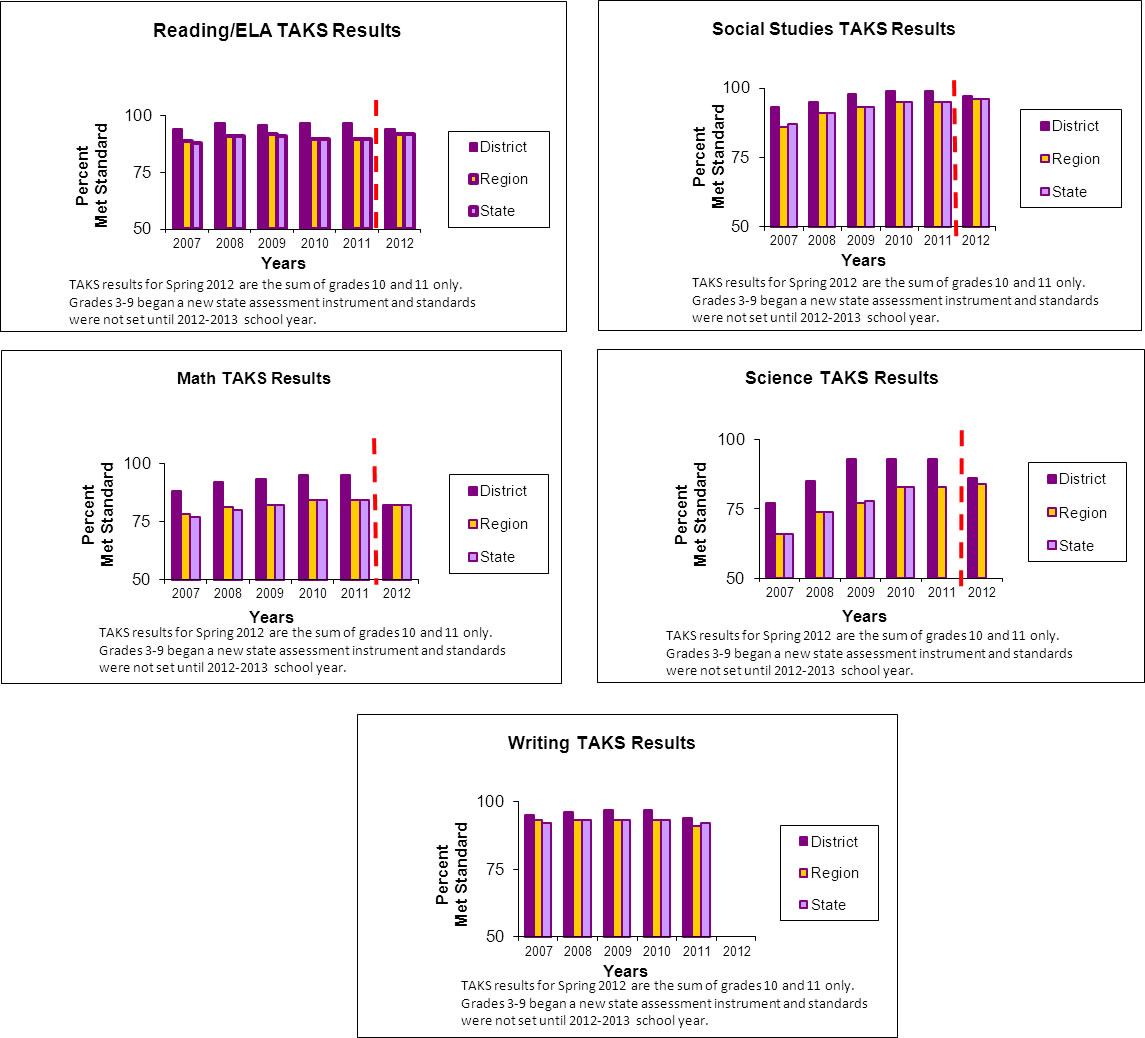
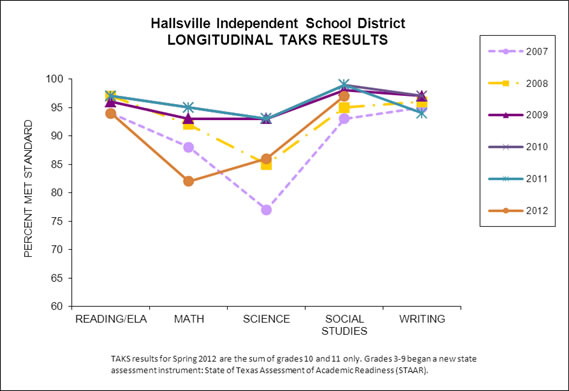
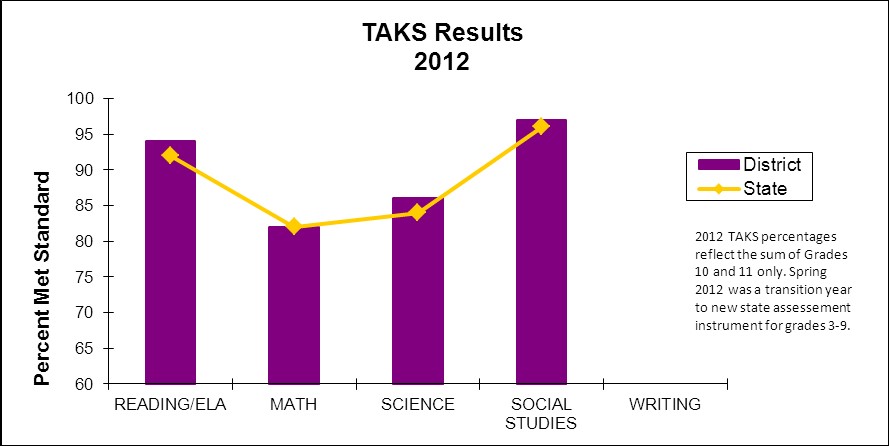
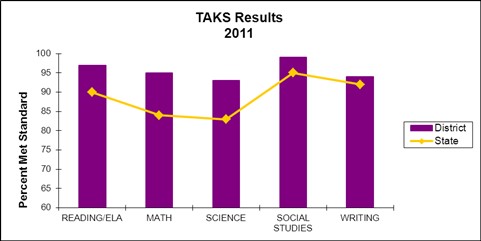
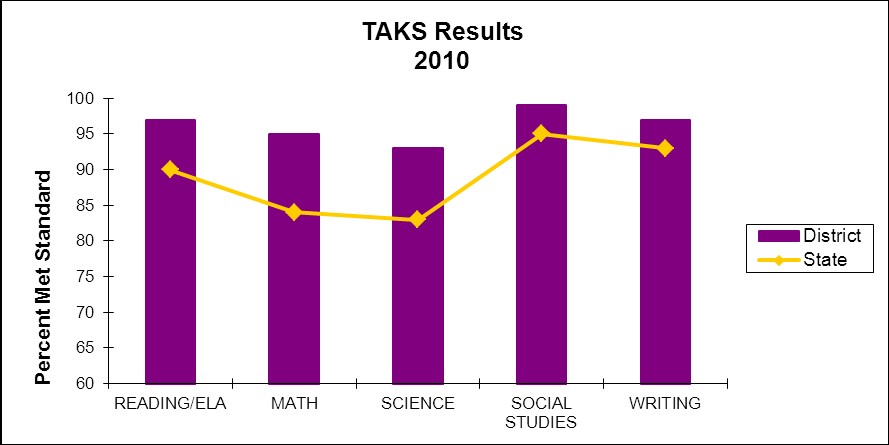
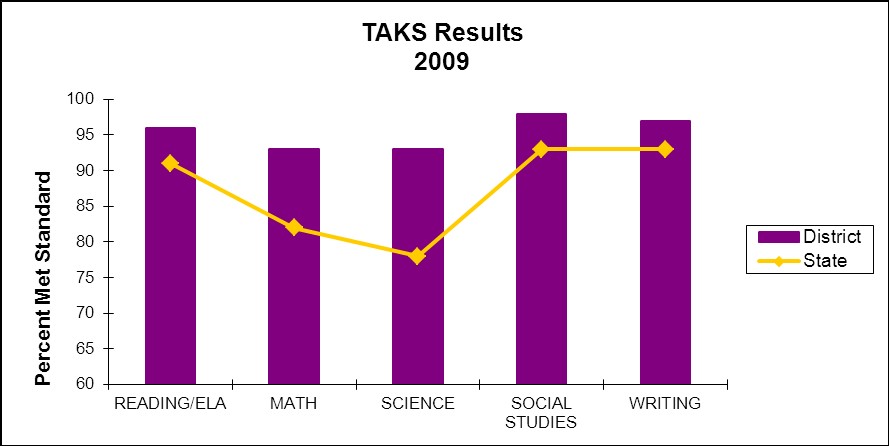
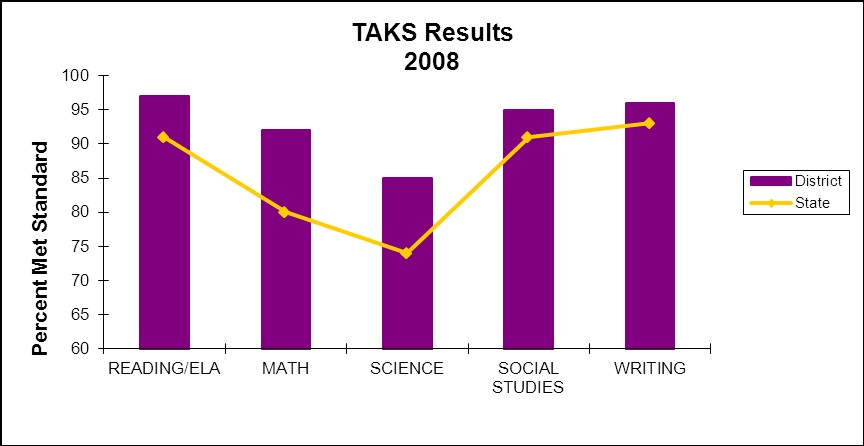


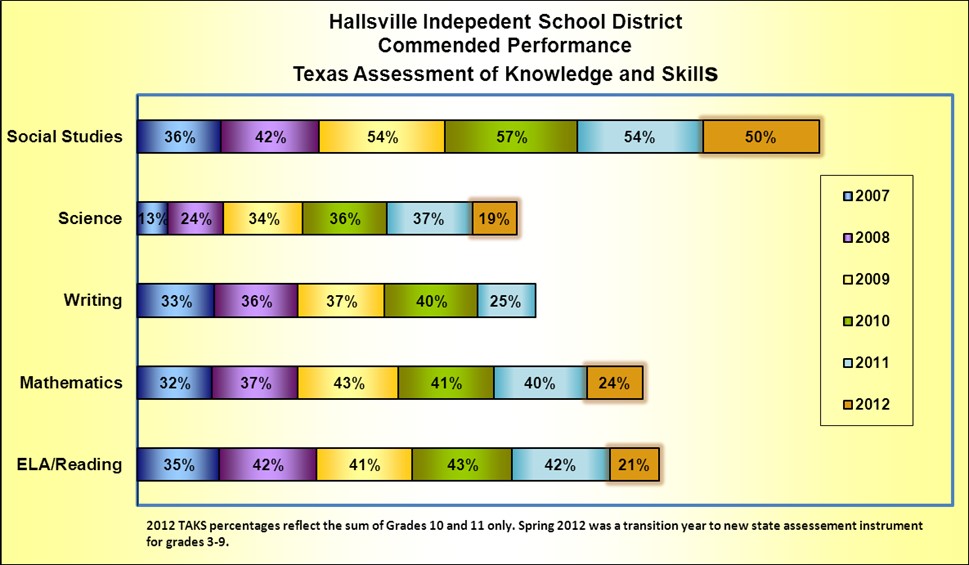
Each Fall we measure graduates who have enrolled in higher education.


The district dropout rate remains significantly below the state average.
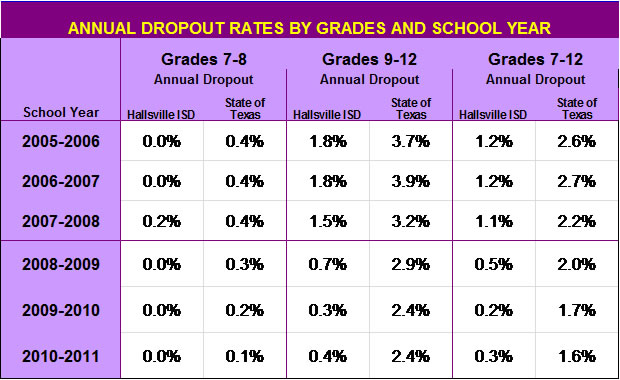
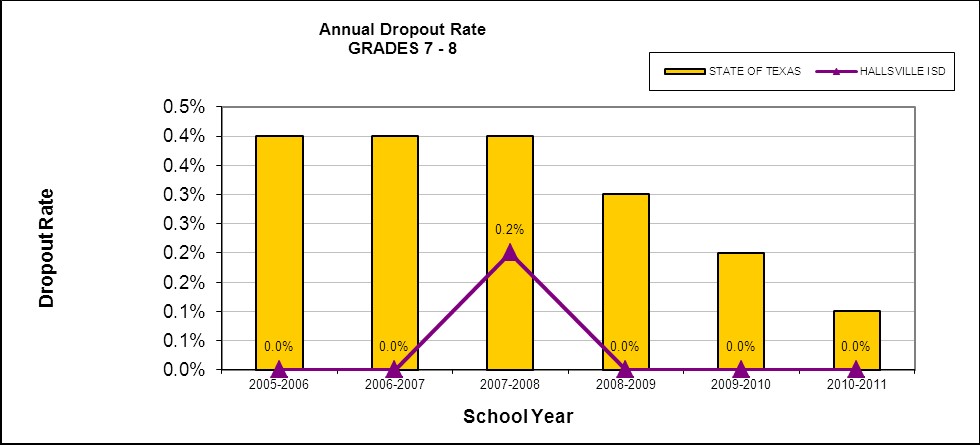
Comments: It is important to note that by all state accountability measures as well as other measures of high achievement that the district has had sustained high achievement since the implementation of PLC concepts. The district consistently exceeds the state percentage of passing at every grade level. Our campuses are recognized for high achievement which includes being recognized as Title I Distinguished Schools at our Title I campuses.
- 2018 HISD receives an "A" Rating from TEA
- 2014-2018 Four campuses and district recognized by Solution Tree as Model PLC schools
- Fall 2018 North Elementary Renamed a Model PLC campus
- 2015-2016 North Elementary Title I, Part A High-Progress Reward School
- Texas Education Agency Met Standard Ratings with multiple campuses receiving Distinction Designations each year (current accountability system)
- Top 100 Best Places to Teach in Texas - niche.com
- Top 100 Best School Districts in Texas - niche.com
- Lone Star Cup - Top Ten Finalist - University Interscholastic League Academic and Athletic achievements (2014 and 2015)
- UIL Academic State Champions - 2014; UIL Academic State Finalists (4th place) - 2015; Champions 2018
- UIL Academic Championship- Ten Consecutive years 2009-2019
- Featured on the Solution Tree website as a success story for RTI at Work practices.
- Texas Elementary Principal of the Year - 2013 (Cristi Parsons - North Elementary)
- Texas Middle School Principal of the Year - 2011 (Dr. Amber Daub - Hallsville Junior High)
- Texas Education Agency Exemplary/Recognized District - 4 years (previous accountability system)
- Texas Education Agency Exemplary North Elementary School - 4 years in a row (previous accountability system)
- Texas Education Agency Exemplary East Elementary School - 2009-2012
- Texas Education Agency Exemplary Intermediate School - 2009-2012
- Texas Education Agency Exemplary Junior High School - 2009-2012
- Texas Education Agency Exemplary High School - 1 year (previous accountability system)
- Title I Distinguished Campuses
- Hallsville ISD has met standards for AYP every year.
- Campuses have received Gold Performance Acknowledgments from the Texas Education Agency each year since 2007.
- NCEA Higher Performing Campus as Hallsville Middle School
- Finalist for “National Schools to Watch” from the National Forum to Accelerate Middle Grade Reform as Hallsville Middle School
- Selected by University of Washington to be included in a national study on effective RTI practices in reading.
- Featured in the Solution Tree video series “Pyramid Response to Intervention – The Four Essential Guiding Principles”.
- Hallsville High School – Silver Medalist – US News and World Report


















